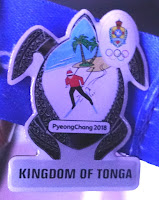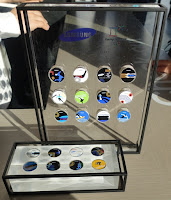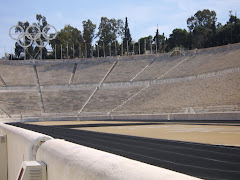 |
| Associated Press |
My longtime friend and fellow International Society of Olympic Historians (ISOH) member J. Brian Carberry spent part of his summer vacation in Scotland.
His mission (in addition to taking the family to an
Ed Sheeran concert): Visit the homeland of Olympic curling.
More specifically, the place where all Olympic competition curling stones are made:
Kays of Scotland.
The following guest post by Carberry tells the tale, initially inspired by a national news story we both spotted a few years ago. Brian also suggested
a video for additional context.
As told by J. Brian Carberry ...
“Oh, Boiling,” expressed factory manager Jim Bright in a
distinctive Scottish dialect, as he walked out to meet me in the modest
industrial granite yard.
The weather was sunny, and the sky was clear with a
temperature of 74 degrees Fahrenheit on this spring day of May 24, 2018. The yard was hot with the whirring of factory
machinery in the background acting as a reminder of the heat index.
It struck me as a counterintuitive setting for a foray into
the ice sport that is curling.
 |
| Korea Times |
Curling is a sport invented in Scotland in the mid-16th
Century, and along with its Summer Olympics counterpart of golf, it represents
this nation’s contribution of sporting cultural heritage to the Modern Olympics
program.
The inaugural 1924 Olympic Winter Games in Chamonix, France,
was the setting of the first Olympic Men’s Curling tournament. This Bonspiel in 1924 was held in a state of
historical limbo for 80+ years. It was
seen by some as an official Olympic event and relegated by others as a mere
demonstration until the tournament was officially recognized with full-fledged
Olympic Medal status by the IOC in 2006.
With the decision, the first, second and third place finishers were definitively elevated to official Olympic medalists.
And at this time (2006), the 1924 Great Britain Men’s team that hailed
from the Royal Caledonian Curling Club in Perth, Scotland, joined the women of the 2002 Salt Lake City Olympics Gold Medal team representing Great
Britain as the only Olympic or Paralympic Gold Medalists in Curling from
Scotland.
There have been seven Olympic tournaments for men, six
Olympic tournaments for women, and one mixed gender Olympic tournament through
2018. As well, there have been four
Paralympic mixed gender tournaments to date.
Scottish curlers won one-sixth or 16.7 percent of all Olympic and
Paralympic gold medals contested.
Likewise with silver and bronze Olympic medals in the Olympics and
Paralympics over the years, Scottish curlers have teamed up to win one-sixth or 16.7 percent of all the medals awarded at the Olympics and Paralympics under the
flag of Great Britain.
Kays of Scotland in Mauchline, Ayrshire, Scotland is where
the world’s finest curling stones, and those used exclusively in International World
Curling Federation Competition including the Olympics, are manufactured from
granite exclusively sourced from the Isle of Ailsa Craig, a distance of 34.2
miles away (according to Google Maps) in the Firth of Clyde.
On the heels of an exciting gold medal-winning
tournament for the Team USA men's curling team in
February 2018 at PyeongChang, curiosity was piqued by a segment on CNBC to visit this
singular locale for the manufacturing of Olympic curling stone implements.
A family tour of Scotland was in the planning and
development stages this past February.
As I followed the Olympic Curling tournament, visiting Kays of Scotland
campus was a stop I suggested for the itinerary.
It seemed like a good idea at the time.
At the appointed time on that Tuesday afternoon, our
traveling group of three drove into the town of Mauchline in Ayrshire. There is little to no indication upon arrival
that this is the world’s capital of curling stone manufacturing. With the address checked and double checked
in the navigation software, I found myself on an apparent residential
street. I happened upon a resident in the
doorway of what surely was a townhouse, but might be a mixed use corporate
office where all indicators suggest should be the locale of the factory’s
address.
After brief discussion with the resident, I was directed to
a small opening in a gate across the street, where was no visible signage.
Unsure of the scene,
I walked into a small yard and eventually spied some circular stones that
could be in the beginning stages of the manufacturing process to become a
curling stone - or they could be garden stones, I pondered.
I ventured
on with a veneer of assured confidence with my unsure family aside, like a
wayward incarnation of a real-life Clark Griswold on some Olympian National
Lampoon romp.
In short order, we were
intercepted by a concerned employee and politely yet firmly directed to an
office where I sensed our arrival was not exactly expected nor understood.
We eventually learned the contact who welcomed us (via email, weeks earlier) to come by for a tour was not at work that day, and I sensed no one was told we would be stopping by for a tour.
In spite of this "surprise" visit, I was invited to examine a display of
souvenir jewelry and miniature curling stone paperweights that served as a
gift shop or at least storage for their website’s
online gift shop.
We perused the
wares as the awkwardness dissipated, and an office worker tried to determine
how to proceed with what is now clearly our unexpected arrival.
As I exited the small office to the yard, curling stones came into view in various states of manufacture or, in the
case of those traded-in for new stones, stored for repurposing.
I was politely informed that
someone would be happy to show me around (perhaps escort me off the grounds)
and briefly answer questions, and I was
presented a professionally produced brochure.
On cue, the aforementioned factory manager Jim Bright
appeared, wearing a work jumpsuit
that displayed the logo for Kays of Scotland I recalled from the website. For the first time since arriving, I was now
convinced (at last) we were indeed in the correct place!
At the same time, I
sensed that I was now the subject of curiosity. Who flies to Europe and drives
out here to look at a small factory with their family in tow on holiday?
After
all, there were state-sanctioned castles and abbey tours to occupy
tourists! It also occurred to me I should
probably be drinking locally sourced single malt whisky about right now.
Mr. Bright turned out to be a generous, albeit impromptu, host who indulged my questions and curiosity for about 25 minutes
while escorting us through the small yet busy complex.
I worried the extent to which we were keeping him from his work, and he informed me that his experience previously
included manufacturing optical lenses to precise specifications; his skills
were well-suited for the precision skill involved in fashioning some of the
most unique granite in the world into world-class sporting implements that must
meet very specific requirements.
In addition,
he informed me that he helped design the machinery for the production of the
small souvenir curling stones that are offered for sale. One such item inevitably became a keepsake/justification
of our visit.
Kays of Scotland does not have a regular open-to-the-public
factory tour and museum. It is not of
the type of outfit found at the Louisville Slugger Baseball Bat Museum and
Factory Tour in Louisville, Kentucky.
Scotland is not the United States where such brand-based manufacturing
tourism not involving whisky has a market I quietly determined.
Perhaps this is rightfully so. Kays of Scotland is a small factory operation, and they
have work to do.
I was getting the vibe
that my family felt we had other touring to get to, but I decided the local
Robert Burns Museum could wait while considering my own thoughts on “the best
laid plans of mice and men.”
I was informed by Mr. Bright that this shop creates
approximately 1,750 competition curling stones per year for shipment to
locations around the world. The process
for each stone involves multiple steps of cutting, joining, diamond cutter
lathing, setting and polishing.
All of
this happens after the raw quarried granite from Ailsa Craig arrives on
sight. In addition, the shop refurbishes
for the recreational market or, in case that is not possible, repurposes
granite for other products from old stones that are traded in on new orders.
From afar, I peered into the facility that
houses the heavy equipment that cuts and polishes the stones.
In the worldwide market for curling stones, Kays of Scotland
and their exclusive mining rights to Ailsa Craig have a sole competitor in the
way of a quarry in Wales where granite is sourced for manufacturing in a Canadian
factory.
Geologists have determined there are two types of granite
from the island: the Blue and the Green.
Both types are used in the component manufacturing for their world-class
stones that players and aficionados have come to revere.
According to Mr. Bright, stones can last over 100 years,
but time, use, storage conditions, climates, and differing ice playing
conditions are all variables that can lead to stones eventually losing their
action, grip or suitability for play at a given locale.
Curling venues have house sets of stones
that all players are required to use for play.
Individual teams and players do not travel with their own curling stones
for play. For this reason, they do not sell stones to individual players.
In essence, the curling stones become part of the venue
insuring Scotland’s role in hosting international Olympic competitions for the
foreseeable future, and thusly contributes to the specialized niche nature of
this business.
As I consider the path from a small granite island in the
British Isles to the spotlight of Olympic Ice in the life of a curling stone,
the Scottish bagpipes laden
hit song by AC/DC comes to mind.
“... It’s a long way to the top if you want to rock'n'roll!”
 Along with "Spooky" (penned by the band's longtime manager and our main contact, Buddy Buie), during that springtime project I also came to appreciate ARS' Southern rock classics including "So Into You" and "Doraville" ("a touch of country in the city") as well as "Imaginary Lover" and "Champagne Jam."
Along with "Spooky" (penned by the band's longtime manager and our main contact, Buddy Buie), during that springtime project I also came to appreciate ARS' Southern rock classics including "So Into You" and "Doraville" ("a touch of country in the city") as well as "Imaginary Lover" and "Champagne Jam." If only the online audience had known we were chatting with them from a state park men's room while hunkered down during the cloudburst (the band's front man Ronnie Hammond was a good sport about this and many other interviews we secured).
If only the online audience had known we were chatting with them from a state park men's room while hunkered down during the cloudburst (the band's front man Ronnie Hammond was a good sport about this and many other interviews we secured).  If only the online audience had known we were chatting with them from a state park men's room while hunkered down during the cloudburst (the band's front man Ronnie Hammond was a good sport about this and many other interviews we secured).
If only the online audience had known we were chatting with them from a state park men's room while hunkered down during the cloudburst (the band's front man Ronnie Hammond was a good sport about this and many other interviews we secured).  The Olympic flag was officially transferred from Barcelona, Spain, the site of the previous Olympiad. Overseen by Dick Clark and Whitney Houston, the event was attended by President George H.W. Bush and his wife."
The Olympic flag was officially transferred from Barcelona, Spain, the site of the previous Olympiad. Overseen by Dick Clark and Whitney Houston, the event was attended by President George H.W. Bush and his wife." The Olympic flag was officially transferred from Barcelona, Spain, the site of the previous Olympiad. Overseen by Dick Clark and Whitney Houston, the event was attended by President George H.W. Bush and his wife."
The Olympic flag was officially transferred from Barcelona, Spain, the site of the previous Olympiad. Overseen by Dick Clark and Whitney Houston, the event was attended by President George H.W. Bush and his wife."
































































